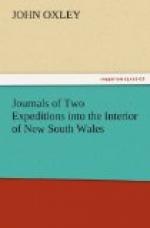June 14.-I had determined to halt this day, for the purpose of verifying our situation by survey, but was prevented by rain of great violence throughout the day, accompanied by strong winds from the north-west; this confined us to our tents.
June 15.—Our journey lay over alternate rich flats and barren stony scrubs; the country irregular, and the banks much elevated: the land to the north-west and north, as far as we could see, (ten or twelve miles) broken into bare, irregular hills and valleys. On the south side of the river the flats were more extended; thick coppices, and tracts of barren land, were also observed on that side. About four miles down the river large blocks of granite were scattered in its bed, and formed the base of the surrounding hills, the tops of which were covered with different kinds of stone, cemented or fused together by the action of fire: many of those stones were beautifully crystallised, and the appearance of some kind of mineral was evident. The river sometimes swept along in fine reaches, then, becoming contracted into narrow rocky channels, rushed through those straits with extreme violence, rendering it difficult to steer the boats clear of the obstructions that presented themselves on every side: the large boat struck twice in those narrows. The water has fallen considerably, and it does not appear to be even now at its usual level; its quality is very hard. The granite we fell in with four miles below our last encampment was of a totally different species, being much finer and closer grained, with small black specks thickly intermingled in the mass; some freestone was also seen. The botany of the country was in all respects the same as observed on our journey homewards last year; the grassy nature of the herbage preventing any material addition to our collection. Kangaroos were in great numbers, and continued to furnish us with a welcome addition to our rations.




